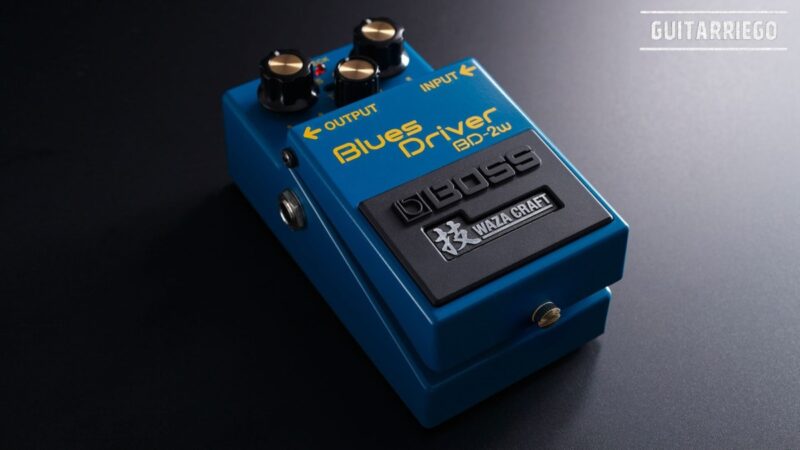Behringer Guitar Pedals: A Comprehensive Analysis

Behringer, the whole truth about these popular cheap guitar pedals, how they keep their prices so low, their quality and which renowned guitar effects pedals they imitate or copy.
Behringer: Low cost guitar effects pedals
If you’ve been on the hunt for new guitar pedals, chances are you’ve come across Behringer’s line of effects. In this article, we’ll delve into several of these units, exploring why they are so affordable. If you’re a pedal enthusiast, be prepared for an interesting journey as we take a closer look at Behringer’s offerings. Before we start, let’s provide some context about Behringer and the foundation it stands upon.
Behringer’s History and Scope
Behringer was established by a young visionary named Uli Behringer in 1989. What began as a small venture has now blossomed into a behemoth in the music industry. Behringer is now a part of the Music Tribe organization, which encompasses other companies like TC Electronics, Turbosound, Midas, and Klark Teknik. The sheer scale of their operations is astounding; they even have their own city in China named Music Tribe City, where they manufacture products in-house. This massive infrastructure contributes significantly to their ability to offer affordable pedals. In addition, Behringer group sells chipset and other parts to other guitar pedal manufacturers as JHS the boutique trademark of Josh Scott.
Visit our selection of the best guitar tuner pedals.
A Different Approach to Pedal Manufacturing
Contrary to smaller boutique pedal manufacturers who often handcraft pedals with limited resources, Behringer’s approach is distinct. If you compare a pedal from Behringer to one from JHS, Wampler, or EarthQuaker Devices, you’re dealing with two different worlds. The former comes from a vast corporation with a global reach, while the latter is the result of smaller, more intimate craftsmanship.
The Pedal Comparison between the Behringer and its original
Let’s embark on a comprehensive comparison of Behringer pedals with their counterparts. We’ll go through various units, exploring their features, similarities, and differences. It’s important to note that while Behringer pedals emulate renowned models, they might exhibit subtle variations due to their manufacturing approach.
Another great option to try effects pedals without breaking the bank is using the Line 6 M5 Stompbox modeler.
Behringer TU300 vs. BOSS TU-2 Chromatic Tuner

We start with the Behringer Chromatic Tuner TU300, which closely resembles the BOSS TU-2. Both serve the purpose of accurate tuning, with the Behringer likely drawing inspiration from the BOSS design.
Behringer CL9 vs. Ibanez CP9 Compressor/Limiter

The Behringer CL-9 Compressor Limiter bears resemblance to the Ibanez CP9. While their aesthetics and circuits align, some modifications set them apart in terms of tonal response. The Behringer CL9 has a better bass response than the Ibanez CP9.
Behringer UO300 Ultra Octaver vs. BOSS OC-2 Octaver
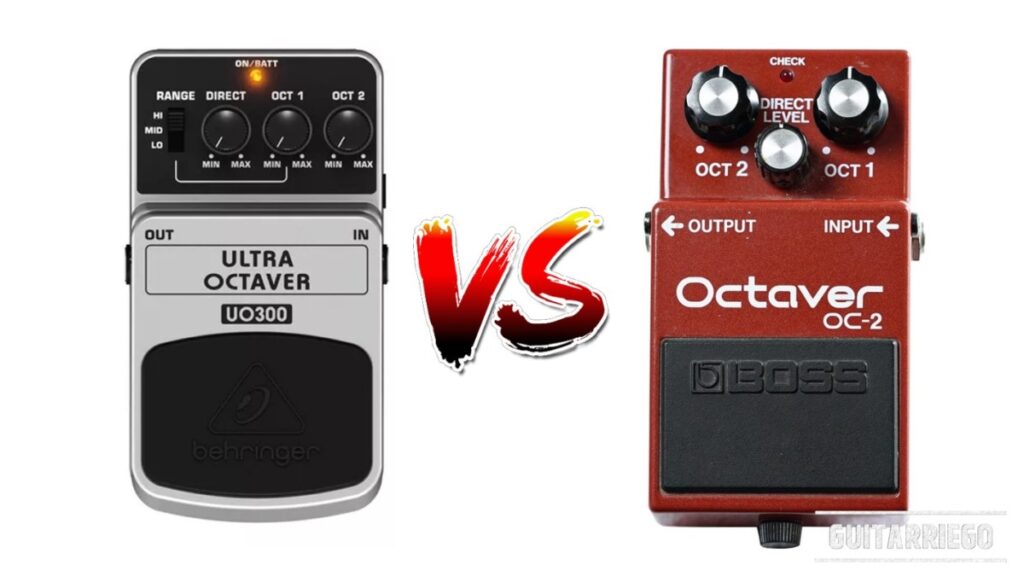
Behringer’s UO300, a modified version of the BOSS OC-2, features switchable octaves. This affordable alternative captures the essence of the OC-2, making it perfect for experimenting with octave effects.
Behringer UT300 Ultra Tremolo vs. BOSS TR-2 Tremolo
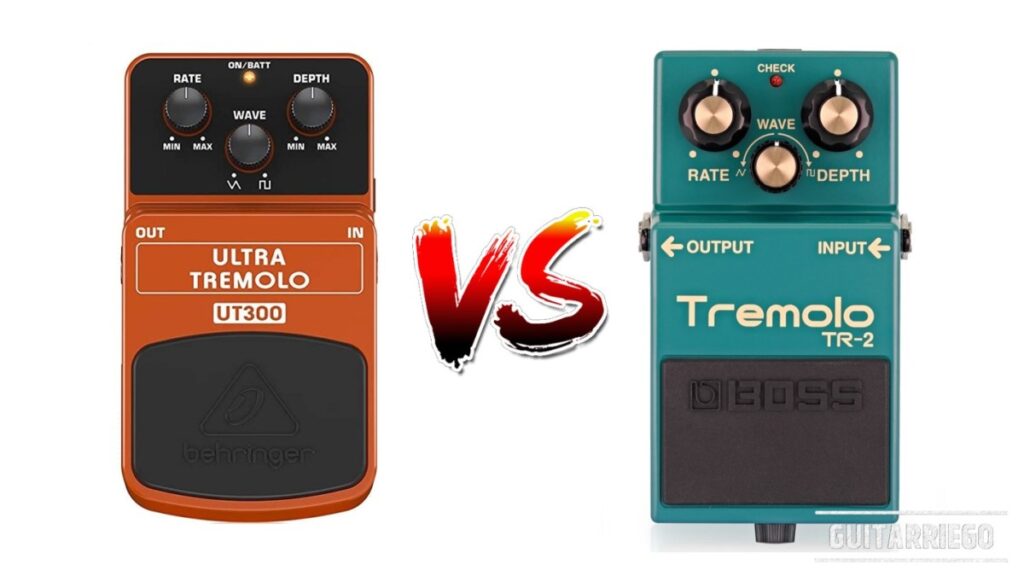
The Behringer UT300 emulates the BOSS TR-2 Tremolo. Although the design is quite similar, they have almost identical sound. Of course, the BOSS counterpart is known for its durability, while the Behringer offers an economical option.
You can also try effects pedals using free online guitar effects pedals plug-ins.
Behringer DR600 vs. BOSS RV-5 Digital Reverb

In the realm of digital reverbs, the Behringer DR600 mirrors the BOSS RV-5. While the core functionality aligns, some sonic differences might arise due to Behringer’s digital emulation approach.
Behringer VD400 Vintage Delay vs. BOSS DM-3 Delay

Behringer’s VD400 Vintage Delay resembles the BOSS DM-3. Both pedals utilize the “Bucket Brigade” technology for their analog delay, making the Behringer version a budget-friendly way to experience this classic sound.
Behringer FM600 Filter Machine vs. Line 6 Auto Filter

Behringer’s FM600 emulates Line 6’s Auto Filter. While the design is nearly identical, the digital algorithms can lead to subtle differences in sound. This budget-friendly option is perfect for exploring envelope filter effects.
Behringer EQ700 Graphic Equalizer vs. BOSS GE-7 Equalizer

The Behringer EQ 700, a 7-band graphic equalizer, bears a striking resemblance to the BOSS GE-7. For those seeking an affordable EQ solution, this pedal offers comparable features.
Visit our guide about guitar equalizer pedals with tips, tricks and all the ways to use it.
Behringer UV300 Ultra Vibrato vs. BOSS VB-2 Vibrato

Behringer’s UV300 stands as a near-identical replica of the sought-after BOSS VB-2 Vibrato. This emulation is a fantastic opportunity to experience the unique vibrato effect of the vintage BOSS pedal.
You may be interested in our post about one of the best classic effects pedals used by Jimi Hendrix: Uni-Vibe.
Behringer UM300 Ultra Metal vs. BOSS MT-2 Metal Zone Distortion

The Behringer UM300 Ultra Metal is a replica of the BOSS MT-2 Metal Zone Distortion pedal. If you want to have multiple Metal Zones without the rest noticing, with the Behringer UM300 you’ll get one for a few bucks less.
Behringer HM300 vs. BOSS HM-2 Heavy Metal Distortion
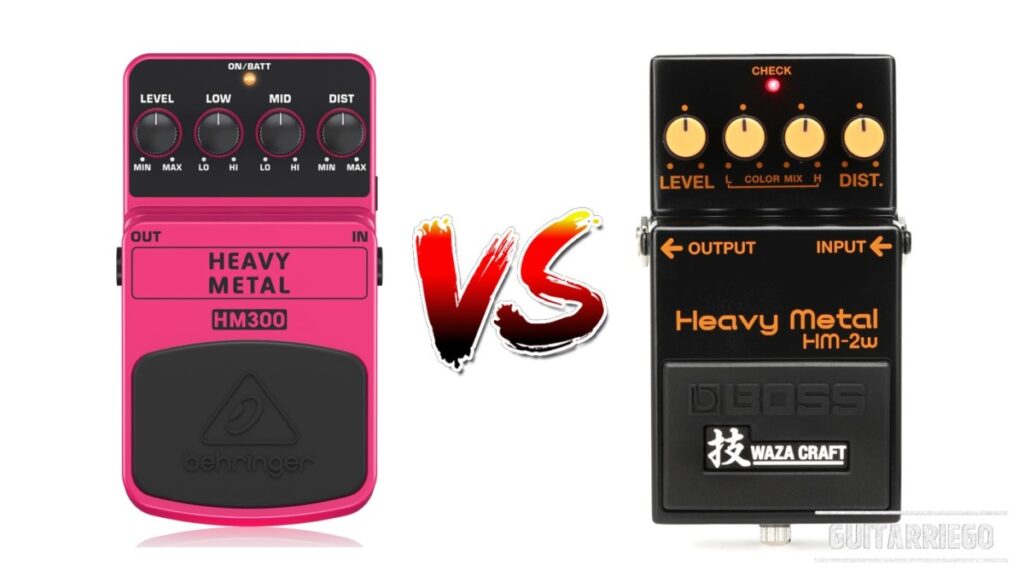
The Behringer HM300 emulates the iconic BOSS HM-2 Heavy Metal Distortion. This pedal replicates the classic tone of the BOSS pedal, providing an affordable way to experiment with heavy distortion.
Another great Boss Distortion Pedal is the Boss DS-1, a classic Distortion pedal.
Behringer NR300 Noise Reducer vs. BOSS NS-2 Noise Suppressor

Behringer’s NR300 Noise Reducer simplifies the BOSS Noise Suppressor’s design. While the BOSS version boasts a knob, the Behringer alternative features a switch, offering effective noise reduction.
Behringer UC200 Ultra Chorus vs. BOSS CH-1 Super Chorus

Behringer’s UC 200 Ultra Chorus closely mimics the BOSS CH-1 Super Chorus. The visual similarities extend to the circuits, making the Behringer option a budget-conscious choice for chorus effects.
Visit our artible about one of the most iconic effects pedals used by Eddie Van Halen: MXR Phase 90.
Behringer TO800 Vintage Tube Overdrive vs. Ibanez Tube Screamer TS808

The Behringer TO800 Vintage Tube Overdrive is inspired by the Ibanez Tube Screamer TS808. While it captures the essence of the vintage Tube Screamer, slight modifications make it a cost-effective alternative for tube-driven overdrive tones.
Behringer Vintage Tuve Machine VM1 vs. Electro-Harmonix Deluxe Memory Man
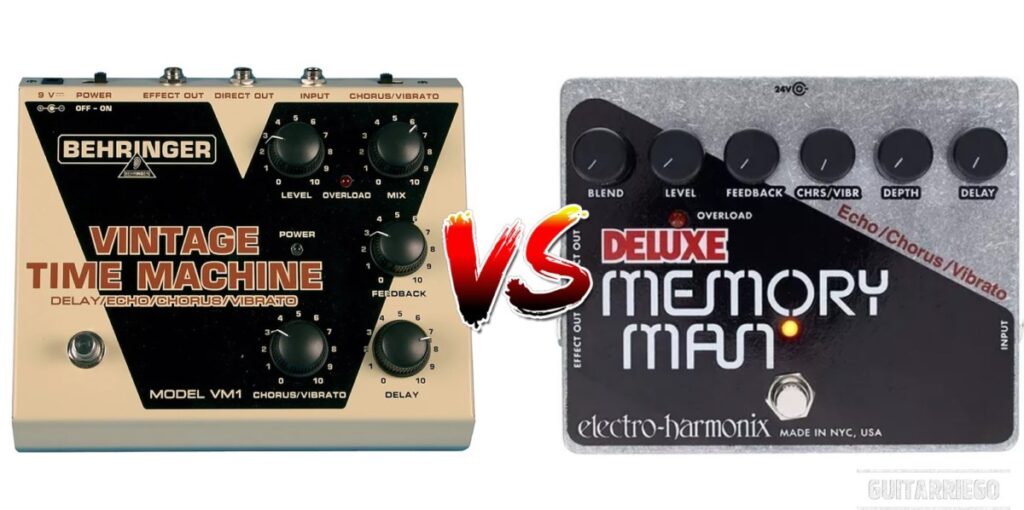
Behringer VM1 Vintage Time Machine, emulating the Electro-Harmonix Deluxe Memory Man, delivers analog delay sounds with slight tonal variations. The pedal offers a budget-friendly way to experience the iconic Memory Man sound.
Behringer Vintage Tube Overdrive VT911 vs. BK Butler Tube Driver
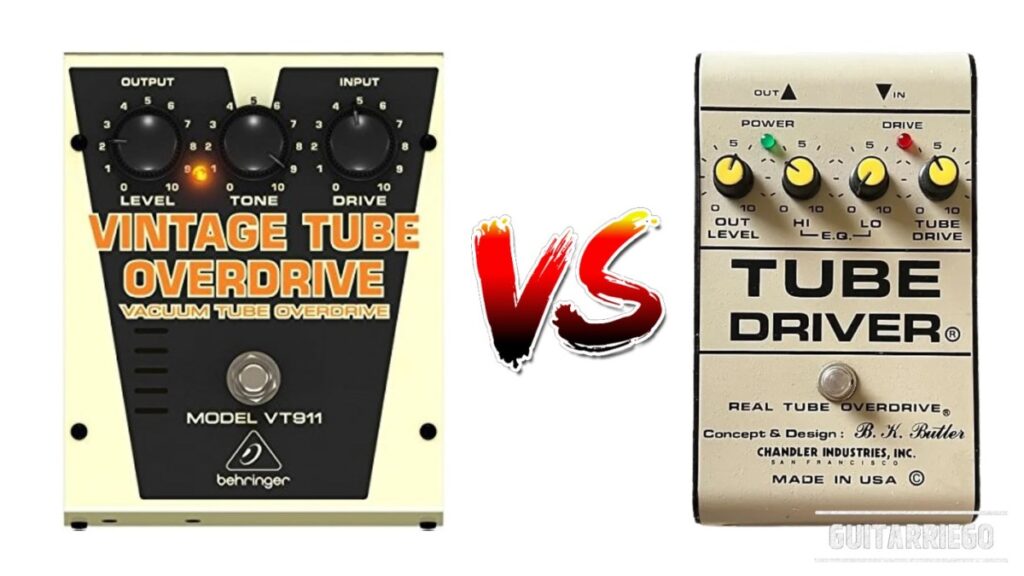
Behringer VT911 Vintage Tube Overdrive, emulating the BK Butler Tube Driver, delivers an iconic vintage overdrive with slight tonal variations. The pedal offers a budget-friendly way to experience the iconic BK Butler Tube Driver.
We also recommend that you see our selection of the best cheap guitar overdrive pedals for beginners.
Behringer CS400 vs. Boss CS-3 Compressor Sustainer

The Behringer CS400 Compressor Sustainer replicates the Boss CS-3. Both effects pedals are very similar, their biggest difference is the color, the Behringer is green, the Boss is blue.
Behringer TM300 Tube Amp Modeler vs. Tech 21 NYC SansAmp GT2

If you’re interested in trying out or buying a Tech 21 NYC SansAmp GT2 pedal but have a limited budget, the Behringer TM300 Tube Amp Modeler Effects Pedal is an excellent option to consider. These are cab and amp simulators, that allow you to go direct in and not use amplifier.
Behringer SF300 Super Fuzz vs. BOSS FZ-2 Hyper Fuzz

Behringer’s SF300 Super Fuzz is an exact replica of the highly sought-after BOSS FZ-2 Hyper Fuzz. This pedal offers the iconic fuzz sound at an affordable price point, making it a must-try for any fuzz enthusiast.
Everything you must know about guitar patch cables: myths, truths and our recommendations.
Final thoughts about Behringer Pedals
In conclusion, Behringer’s line of guitar pedals presents an opportunity for guitarists to explore a wide array of effects without breaking the bank. While they closely emulate renowned models, subtle differences in circuits, components, and manufacturing approaches can yield unique tones. Choosing between Behringer and other brands often comes down to personal preference, budget, and long-term value.
Remember, each pedal offers its own sonic character, and it’s essential to try them out and see how they integrate with your playing style. Ultimately, these pedals provide an accessible gateway for players to experiment with various effects and tones, fostering creativity and musical exploration. Whether you’re a budget-conscious musician or an aficionado of vintage effects, Behringer’s offerings certainly deserve consideration in your pedal lineup.
You may be interested in the guitarist’s guide to the CAGED System.






